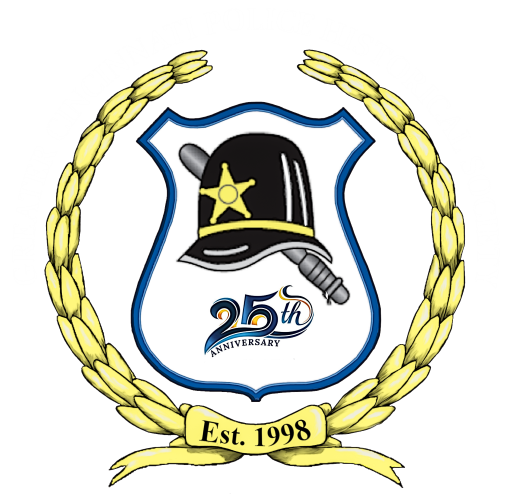
The Greater Cincinnati Police Museum
“Preserving the History of Law Enforcement in the Greater Cincinnati Area”
-by Greater Cincinnati Police Museum Historian LT Stephen R. Kramer RET
At the same time our founders were landing at what was to become Columbia Township, Cincinnati, and North Bend during late 1788 and early 1789, the United States government was wrestling over a new constitution because the Articles of Confederation were not sufficient to govern a nation at peace.
The new United States Constitution and Bill of Rights (written by the 1st Congress) were ratified in 1791. Among all things necessary to govern this new republic, thy documented then and for the next 230 years how our nation would be defended from without and within, including stipulating that the Militia would be responsible for enforcement of federal law. Then, in 1792, based on the new law of the land, the United States (2nd) Congress set forth in the Militia Acts of 1792 exactly what the Militia was, every freeman between the ages of 18 and 46.
Soon after, in 1803, Ohio became a state, the military moved out due to the constitutional mandate that there be no standing armies within a state, and the Council of Cincinnati, the largest municipality in the region, had to decide what they would do for its law enforcement. They looked to the Constitution and Militia Acts and, on March 29, 1803, passed an ordinance designating every citizen, 21 years old and older, to be members of the Night Watch.
Cincinnati was the first city incorporated under the new Constitution. Their unique method of local law enforcement, i.e., of, by, and for The People, observed no artificial and changeable jurisdictional boundaries. As Cincinnati grew and people outside Cincinnati needed help, Cincinnatians helped. Soon, every village, township, and some unincorporated areas developed their version of a citizen watch, and all helped each other.
By 1849, Cincinnati comprised only 16 blocks (Ohio River to Liberty Street) by about 20 blocks but was home to 115,000 people. Soon it would become the sixth largest city in the United States and the big five were all clustered 500 miles away on the other side of the Allegheny Mountains. Cincinnati’s influence went far, into most of Ohio, Indiana, and Kentucky, more than 100 miles in every direction.
Eventually, a few, then many, then by ordinance all the citizens began to hire men to accomplish the task of law enforcement and by the 1840s they had ceded almost all their responsibilities over to a few men elected in each of Cincinnati’s wards. In 1851, Cincinnati City Council passed an ordinance putting the entire responsibility under the city government. Outside of Cincinnati, citizens in vigilante groups called protective associations, rangers, detective agencies, etc. thrived; some as late as the 1950s.
In Cincinnati, government corruption spoiled the police force, and the State of Ohio took over in 1886. They disbanded the entire force of 400 men and created a non-partisan Public Safety Commission who recreated the police department. These new officers had to pass several rigid exams, including intellectual, psychological, physical, and medical. This was new to law enforcement worldwide. Now it is commonplace.
Cincinnati became the first in many things thereafter.
Criminals used the latest technology, railroads, to quickly get away after committing their crimes. In 1894, Cincinnati Police Superintendent Philip Deitsch established the National Police Association to coordinate with each of the other chiefs and departments with techniques and criminal intelligence. He was its first president, and it eventually became the well-known International Association of Chiefs of Police (IACP).
He further realized a need for a uniform method for identifying criminals, collecting their data in one place, and distributing the data from and to all other departments. He established under the IACP the National Bureau of Identification in 1897 which is now housed at the Federal Bureau of Investigation.
Cincinnati Police Chief William Copelan recognized the need for standardizing offense reporting. He established a uniform reporting system within the Cincinnati Police Department in 1927 and the next year it was adopted by the FBI and IACP as Uniform Crime Reporting (UCR). It still exits today.
The root of cooperation between all entities was, in 1819, dubbed “Juncta Juvant” (literally translated, “things joined together are helpful”) and still exists to this day. In 1937, to formalize that cooperation, the Hamilton County Police Association (HCPA) was born, bringing together every one of 57 local, township, county, state, and federal law enforcement agencies in Hamilton County. It was so unique then, that FBI Director J. Edgar Hoover traveled to Cincinnati to assess it and opined that it should be emulated nationwide. It is still unique in Greater Cincinnati today.
Soon, the HCPA was responsible for a regional police academy, monthly firearms proficiency shoots, a unified response to alarms, and its premier product in 1969, a unified Regional Crime Information Center that every agency contributes to – also unique in the country.
The HCPA also maintains a regional SWAT team, underwater search and recovery team, police clergy team, and many other useful ventures. In 2005, every agency in the county began using the same radios, dispatch systems, in-car-computers, etc.
We are the only major metropolitan region in the country, the world, where organized crime cannot long exist, because we always work together to root it out.
The cooperation continues today, not just within Hamilton County, but across the river and across state boundaries. It is the specific reason that during August 1998, when the committee first met to discuss the creation of a historical society and museum, they immediately and unanimously determined to call their venture the GREATER Cincinnati Police Historical Society and Museum.
Please feel free to ask any questions of our Historian at Historian@Police-Museum.org.


